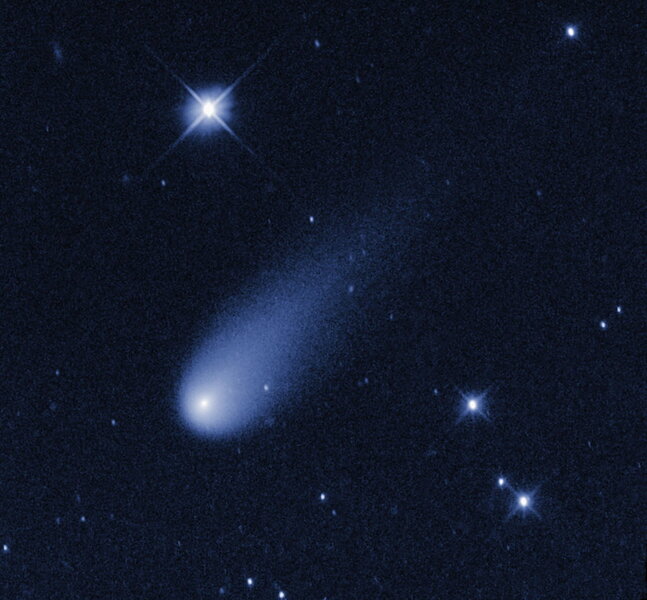What is Comet ISON, possible 'comet of the century,' doing now?
Loading...
Comet ISON is being watched.
As part of the Comet ISON Observing Campaign, astronomers fixed NASA's Spitzer Space Telescope on Comet ISON for 24 hours on June 13th. The results now show carbon dioxide emissions from the comet, which is expected to make a much anticipated journey within several thousand miles of the sun to become – maybe – one of the world's most famous comets.
Scientists believe that about 2.2 million pounds of the gas per day is fizzling off the "soda-pop comet,” drawing behind the comet a tail about 186,400 miles long. The stream is also made of the some 120 million pounds of dust that the comet loses each day.
That tail is expected to get even longer and brighter – if the comet survives long enough for that to happen.
ISON, a "sungrazer” comet, is expected to pass within 750,000 miles of the sun on November 28, 2013. There, it could disintegrate in the sun’s broil and radiation, as do so many comets that dare to come too close.
"Think of ISON as a big block of ice, and if it is not large enough, it will all melt and then boil away," said Carey Lisse, leader of NASA's Comet ISON Observation Campaign and a senior research scientist at the Johns Hopkins University Applied Physics Laboratory.
To make it past the sun, ISON must have a nucleus with a radius larger than a third of a mile. Current estimates put the radius at at too small, at about an eighth of a mile, said Dr. Lisse. But the comet could be larger than that, perhaps 0.6 miles to 1.25 miles wide.
And so, Comet ISON has become something of a betting game. ISON is now less than 3 miles in diameter and has a mass of somewhere between 7 billion and 7 trillion pounds.
ISON still has millions of miles to go before it reaches the sun: the observations on the comet’s CO2 levels were made when ISON was about 312 million miles from the sun, about 3.35 times farther out than Earth. Scientists will have a better understanding of the comet’s size and composition later this month or in August, when the comet begins to warm up around Mars’ orbit.
If ISON does not burn up, it is expected to be the “comet of the century,” both for its fantastic tail that will be visible to the naked eye in the January skies – a prime shooting “star” on which to make a wish for 2014 – and its value to astronomers observing its behavior.
Even if the comet does not make it past the sun, it will still be a scientific boon to astronomers as it speeds past Mars, where two of Mars's active rovers – Curiosity and Opportunity – could take its picture, and then whizzes past Mercury and approaches our star.
"I will not bet if ISON survives solar passage," said Lisse. "I will bet, though, that it will be fantastic at Mars."








